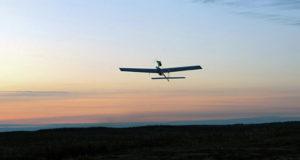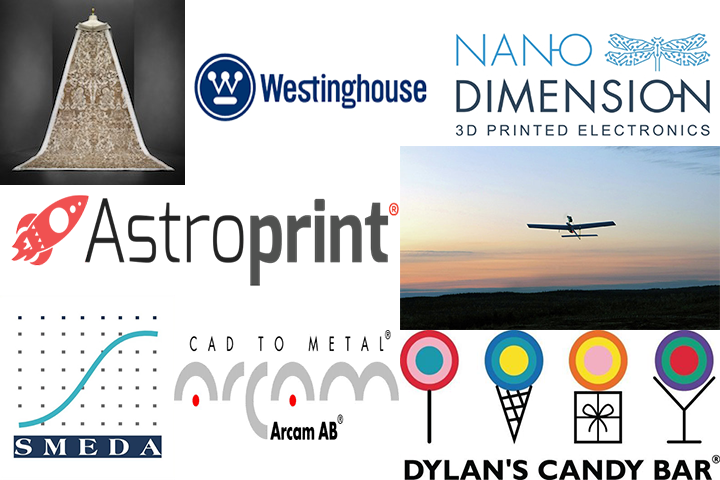3D Printing: The Stories We Missed This Week — July 16, 2016
As we approach the midway point of July, this summer has proven to be a fruitful one for the 3D printing industry thus far. This week, the Metropolitan Museum of Art’s Costume Institute has extended the viewing of its “Manus x Machina” exhibition, a tech-driven fashion collection that includes a number of 3D printed garments. The Russian United Instrument Manufacturing Corporation (UIMC) presented the country’s first-ever 3D printed drone at the Innoprom trade fair. AstroPrint released statistics and trends gathered from the users of their cloud slicing platform. Out in Canada, the Sweden-headquartered 3D printing manufacturer Arcam AB is investing $31 million to build their second Montreal-area plant. The US Department of Energy (DOE) recently selected Westinghouse Electric Company to receive $8 million in research awards, which will go towards R&D for laser-based 3D printing. The New York-based candy company Dylan’s Candy Bar highlighted their Magic Candy Factory 3D gummy candy printer on ABC’s Good Morning America. The electronics 3D printing company Nano Dimension filed a patent application to develop a new nanometric conductive ink, which is based on a unique synthesis. Lastly, the Pakistan-based Small and Medium Enterprises Development Authority (SMEDA) has announced that they will set up a institute geared towards 3D printing education and use.
The Met to Extend “Manus x Machina” Tech-Fashion Exhibit Amid Initial Success
 Late last year, we received word that 3D printing technology would play a major role in the New York City-based Metropolitan Museum of Art’s “Manus x Machina: Fashion in an Age of Technology” exhibition. The exhibit explores the many crossroads between fashion and technological innovation, which includes a handful of 3D printed dresses from renowned designers like Iris van Herpen and Noa Raviv. After bringing in over 350,000 visitors during the first nine weeks of public showing, the Met’s Costume Institute has decided to extend the exhibition to September 5, rather than the originally scheduled closing date on August 14. “Manus x Machina” explores the extensive relationship between using handmade and machine-made methods to design haute couture and ready-to-wear fashion. In addition to the 3D printed pieces, the exhibit will also feature displays with items from Burberry, Alexander McQueen, Lanvin, Christian Dior, and Louis Vuitton.
Late last year, we received word that 3D printing technology would play a major role in the New York City-based Metropolitan Museum of Art’s “Manus x Machina: Fashion in an Age of Technology” exhibition. The exhibit explores the many crossroads between fashion and technological innovation, which includes a handful of 3D printed dresses from renowned designers like Iris van Herpen and Noa Raviv. After bringing in over 350,000 visitors during the first nine weeks of public showing, the Met’s Costume Institute has decided to extend the exhibition to September 5, rather than the originally scheduled closing date on August 14. “Manus x Machina” explores the extensive relationship between using handmade and machine-made methods to design haute couture and ready-to-wear fashion. In addition to the 3D printed pieces, the exhibit will also feature displays with items from Burberry, Alexander McQueen, Lanvin, Christian Dior, and Louis Vuitton.
Defense Contractor Creates Russia’s First-Ever 3D Printed Drone
 Over this last week, at the Yekaterinburg, Russia-based annual Innoprom industrial trade fair, the Russian United Instrument Manufacturing Corporation (UIMC) presented the first 3D printed unmanned aerial vehicle (UAV) to be manufactured in Russia. In a public statement, the UIMC explained that the 3D printed drone was designed to undertake reconnaissance and monitoring missions. According to the defense contractor, this type of drone could essentially be created within a day, while spare parts would take just 15-20 minutes to print. The UIMC is a subsidiary of Russia’s state technologies corporation Rostec, which develops products for high-tech and communication systems. The 2016 Innoprom trade fair, which was held from July 11 to 14, was focused on the integration of production and data transfer, new manufacturing architecture, international cooperation, and new models of efficient manufacturing for traditional industries.
Over this last week, at the Yekaterinburg, Russia-based annual Innoprom industrial trade fair, the Russian United Instrument Manufacturing Corporation (UIMC) presented the first 3D printed unmanned aerial vehicle (UAV) to be manufactured in Russia. In a public statement, the UIMC explained that the 3D printed drone was designed to undertake reconnaissance and monitoring missions. According to the defense contractor, this type of drone could essentially be created within a day, while spare parts would take just 15-20 minutes to print. The UIMC is a subsidiary of Russia’s state technologies corporation Rostec, which develops products for high-tech and communication systems. The 2016 Innoprom trade fair, which was held from July 11 to 14, was focused on the integration of production and data transfer, new manufacturing architecture, international cooperation, and new models of efficient manufacturing for traditional industries.
AstroPrint Releases 3D Printing Statistics and Trends From Their User Base
 In preparation for their new public API, the cloud slicing platform AstroPrint has been gathering data from their users to help break down the latest trends and statistics from their 3D printing community. The data shows that print time by their user base has been steadily rising since November 2015, as their users are averaging a hearty 115 hours of print time each. As far as 3D printers used with the AstroPrint cloud platform, they found that the PrintrBot Simple Metal 3D printer was the most popular, followed by AirWolf 3D’s AW3D HD2x and the Flashforge Creator Pro. As for 3D printers with the most print time, the Airwolf 3D AW3D HDR leads the pack by a handsome amount, followed by the three printers that rounded out the top of the most popular list. As far as the most used slicer on AstroPrint, Cura leads Slic3r by a wide margin, while most users have claimed to use custom settings to achieve the best print quality.
In preparation for their new public API, the cloud slicing platform AstroPrint has been gathering data from their users to help break down the latest trends and statistics from their 3D printing community. The data shows that print time by their user base has been steadily rising since November 2015, as their users are averaging a hearty 115 hours of print time each. As far as 3D printers used with the AstroPrint cloud platform, they found that the PrintrBot Simple Metal 3D printer was the most popular, followed by AirWolf 3D’s AW3D HD2x and the Flashforge Creator Pro. As for 3D printers with the most print time, the Airwolf 3D AW3D HDR leads the pack by a handsome amount, followed by the three printers that rounded out the top of the most popular list. As far as the most used slicer on AstroPrint, Cura leads Slic3r by a wide margin, while most users have claimed to use custom settings to achieve the best print quality.
Arcam AB to Invest $31 Million in Second Montreal-Based Manufacturing Plant
 Canadian metal powders manufacturer Advanced Powders & Coatings (AP&C), a subsidiary of the Sweden-based additive manufacturing company Arcam AB, has announced plans to construct their second plant in Montreal. AP&C will invest $31 million to construct the highly-automated facility, which will be utilized to develop metal powders for 3D printing technology. The expansion is projected to create 106 additional jobs, more than doubling the workforce already stationed at AP&C’s other Quebec-based plant. With their new facility, the company expects to expand production significantly starting next year. After positioning themselves as a primary supplier for Arcam AB, AP&C was acquired by Arcam back in 2014 for $35 million. All in all, the project is estimated to take three years to complete.
Canadian metal powders manufacturer Advanced Powders & Coatings (AP&C), a subsidiary of the Sweden-based additive manufacturing company Arcam AB, has announced plans to construct their second plant in Montreal. AP&C will invest $31 million to construct the highly-automated facility, which will be utilized to develop metal powders for 3D printing technology. The expansion is projected to create 106 additional jobs, more than doubling the workforce already stationed at AP&C’s other Quebec-based plant. With their new facility, the company expects to expand production significantly starting next year. After positioning themselves as a primary supplier for Arcam AB, AP&C was acquired by Arcam back in 2014 for $35 million. All in all, the project is estimated to take three years to complete.
“This investment means that we can provide our existing and future clients with superior quality materials to meet the high manufacturing standards of the aerospace and biomedical industries,” said Arcam AB President and CEO Alain Dupont.
The US Department of Energy Awards Westinghouse With $8 Million in Research Funding
 The US Department of Energy has announced that they will be providing the Westinghouse Electric Company and their research partners with $8 million to fund a series of projects over the next three years. The funding will go towards 11 total research projects, each of which aim to advance our nuclear technology. A primary focus for Westinghouse will be looking at commercially viable methods to 3D print nuclear components, including the development of a laser-based 3D printing technique to create metal parts that are certified for use in nuclear structural applications. By utilizing 3D printing to create nuclear components, Westinghouse will be able to manufacture the most complex parts without the need for tooling and other expensive and time-consuming traditional methods. In addition to 3D printing technology, the funding will also be used to develop self-powered wireless sensors, as well as research into the behavior of corrosion-resistant uranium silicide fuels and acoustic communication along metal pathways in nuclear facilities.
The US Department of Energy has announced that they will be providing the Westinghouse Electric Company and their research partners with $8 million to fund a series of projects over the next three years. The funding will go towards 11 total research projects, each of which aim to advance our nuclear technology. A primary focus for Westinghouse will be looking at commercially viable methods to 3D print nuclear components, including the development of a laser-based 3D printing technique to create metal parts that are certified for use in nuclear structural applications. By utilizing 3D printing to create nuclear components, Westinghouse will be able to manufacture the most complex parts without the need for tooling and other expensive and time-consuming traditional methods. In addition to 3D printing technology, the funding will also be used to develop self-powered wireless sensors, as well as research into the behavior of corrosion-resistant uranium silicide fuels and acoustic communication along metal pathways in nuclear facilities.
“This is a valuable opportunity for Westinghouse to advance our most innovative nuclear technologies while collaborating across the industry with the best minds in the most advanced research facilities,” said Jim Brennan, Senior Vice President of the Engineering Center of Excellence at Westinghouse. “Our priority is to develop technology for existing nuclear facilities and advanced nuclear plants to assure the vitality and economic viability of the nuclear fleet.”
Dylan’s Candy Bar Presents the Magic Candy Factory Candy Printer on ‘Good Morning America’
 Founded by Dylan Lauren in 2001, Dylan’s Candy Bar has solidified itself as a staple sweet spot for New Yorkers (for me, at least). This past week, on ABC’s ‘Good Morning America,’ Lauren joined the show to demonstrate the Magic Candy Factory, a candy 3D printer developed by Katjes Fassin UK Ltd. The exclusive partnership between the candy 3D printer manufacturer and Dylan’s Candy Bar marks the first time that the Magic Candy Factory printer is utilized by a business in the United States. The gummy 3D printer will allow Dylan’s Candy Bar customers to go onto their personalized online shop and create their own custom 3D printed sweet treats. Not only is the Magic Candy Factory capable of producing candy in under five minutes, it also uses a gummy material that is vegan, kosher, and dairy-free. On ‘Good Morning America,’ Lauren showed off three gummy portraits of some of the show’s hosts, George Stephanopoulos, Michael Strahan, and Amy Robach. By integrating the candy 3D printer into their personalized shops, customers will be able to choose from hundreds of preset designs or even upload their own custom candy models.
Founded by Dylan Lauren in 2001, Dylan’s Candy Bar has solidified itself as a staple sweet spot for New Yorkers (for me, at least). This past week, on ABC’s ‘Good Morning America,’ Lauren joined the show to demonstrate the Magic Candy Factory, a candy 3D printer developed by Katjes Fassin UK Ltd. The exclusive partnership between the candy 3D printer manufacturer and Dylan’s Candy Bar marks the first time that the Magic Candy Factory printer is utilized by a business in the United States. The gummy 3D printer will allow Dylan’s Candy Bar customers to go onto their personalized online shop and create their own custom 3D printed sweet treats. Not only is the Magic Candy Factory capable of producing candy in under five minutes, it also uses a gummy material that is vegan, kosher, and dairy-free. On ‘Good Morning America,’ Lauren showed off three gummy portraits of some of the show’s hosts, George Stephanopoulos, Michael Strahan, and Amy Robach. By integrating the candy 3D printer into their personalized shops, customers will be able to choose from hundreds of preset designs or even upload their own custom candy models.
Nano Dimension Files Patent for New Nanometric Conductive Ink
 This past week, the Israel-based electronics 3D printing company Nano Dimension filed a patent with the US Patent and Trademark Office for the development of a new nanometric conductive ink. The new ink, which is based on a unique synthesis, will help minimize the size of silver nanoparticles in the company’s product line. According to Nano Dimension, the new process will allow them to achieve silver nanoparticles as small as four nanometers. The newly developed ink will enable lower melting temperatures and more complete sintering, which in turn will lead to a higher level of conductivity. The innovative ink has the potential to help accelerate printing speeds and save ink for 3D printed electronics such as printed circuit boards, antennas, and more. All in all, the new ink stands to improve the functionality of Nano Dimension’s DragonFly 2020 3D printer, which is still under development. The company plans to commercialize their ink products as supplementary to their 3D printers as well as independent products.
This past week, the Israel-based electronics 3D printing company Nano Dimension filed a patent with the US Patent and Trademark Office for the development of a new nanometric conductive ink. The new ink, which is based on a unique synthesis, will help minimize the size of silver nanoparticles in the company’s product line. According to Nano Dimension, the new process will allow them to achieve silver nanoparticles as small as four nanometers. The newly developed ink will enable lower melting temperatures and more complete sintering, which in turn will lead to a higher level of conductivity. The innovative ink has the potential to help accelerate printing speeds and save ink for 3D printed electronics such as printed circuit boards, antennas, and more. All in all, the new ink stands to improve the functionality of Nano Dimension’s DragonFly 2020 3D printer, which is still under development. The company plans to commercialize their ink products as supplementary to their 3D printers as well as independent products.
SMEDA To Create 3D Printing Institute in Pakistan
 Out in the Middle East, the Pakistan-based organization Small and Medium Enterprises Development Authority (SMEDA) has revealed their plans to develop the institute of Printing and Packaging Technology (IP&PT), which will key in 3D printing education and benefits. According to the president of the Union of Small and Medium Enterprises (UNISAME), Zulfikar Thaver, the institute is needed to help the country meet the global challenges for their packaging designing and attractive packing. This type of 3D printing technology institution was requested by UNISAME back in 2007, but at the time, Pakistani policy makers were unaware of the immense benefits that 3D printing technology could provide to the packaging industry. Discuss these topics further in the 3D Printing News This Week forum over at 3DPB.com.
Out in the Middle East, the Pakistan-based organization Small and Medium Enterprises Development Authority (SMEDA) has revealed their plans to develop the institute of Printing and Packaging Technology (IP&PT), which will key in 3D printing education and benefits. According to the president of the Union of Small and Medium Enterprises (UNISAME), Zulfikar Thaver, the institute is needed to help the country meet the global challenges for their packaging designing and attractive packing. This type of 3D printing technology institution was requested by UNISAME back in 2007, but at the time, Pakistani policy makers were unaware of the immense benefits that 3D printing technology could provide to the packaging industry. Discuss these topics further in the 3D Printing News This Week forum over at 3DPB.com.
Subscribe to Our Email Newsletter
Stay up-to-date on all the latest news from the 3D printing industry and receive information and offers from third party vendors.
Print Services
You May Also Like
New Business: Temporary, Migratory, & Modular 3D Printed Architecture
If we look at potentially emerging 3D printing businesses, then architecture has not been fully explored. Yes, there is a lot of house 3D printing going on worldwide. From deployable...
3D Printing News Briefs, April 19, 2025: Material Extrusion Standard, Metal Powder, & More
In today’s 3D Printing News Briefs, we’re covering a proposed standard for material extrusion, before moving on to business and metal powder. We’ll end with a commercial store’s robotic 3D...
Japan Unveils World’s First 3D Printed Train Station
Japan is now home to what we believe is the world’s first train station built with 3D printing technology. Located in Arida City, just south of Osaka, the new Hatsushima...
restor3d Raises $38M to Expand 3D Printed Orthopedic Implants
Backed by $38 million in new funding, restor3d is pushing ahead with the launch of four personalized implant lines, set to roll out in 2025 and 2026. This latest venture...


























